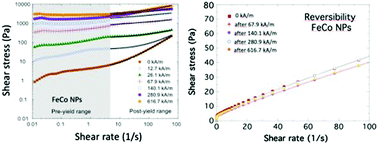High magnetization FeCo nanoparticles for magnetorheological fluids with enhanced response†
Abstract
We present results concerning the fabrication of a new magnetorheological fluid with FeCo magnetic nanoparticles (NPs) as magnetic fillers. These NPs have been fabricated by using the chemical reduction technique and show a pure crystalline phase with size ranging among 30–50 nm and high magnetization, 212 ± 2 A m2 kg−1. They agglomerate due to the strong magnetic dipolar interaction among them. These FeCo nanoparticles were used to synthesize a magnetorheological fluid by using oleic acid as surfactant, mineral oil as carrier liquid and Aerosil 300 as additive to control the viscosity of the fluid. The synthesized fluid showed a strong magnetorheological response with increasing shear stress values as the magnetic field intensity increases. Thus, we have measured a superior performance up to 616.7 kA m−1, with a yield stress value of 2729 Pa, and good reversibility after demagnetization process. This value competes with the best ones reported in the most recent literature. We have compared the obtained results with our previous reported ones by using high magnetization Fe NPs fabricated by the electrical explosion of wire method (Fe-EEW).



 Please wait while we load your content...
Please wait while we load your content...